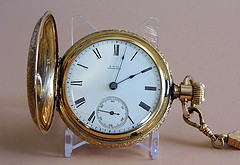I was reading up on wearable computing today, and with the SDCC badge presale looming, I found myself wondering whether a smart watch would be useful for Comic-Con. (No plans to actually buy one, I’m just thinking.) I don’t normally wear a watch these days, but it does get annoying to have to reach into my pocket when I want to check the time. For this reason, I make a point to wear a watch at conventions so that I can see the time at a glance and avoid missing events or meetup times.
So, keeping in mind that the current generation of smart watches (Pebble, Galaxy Gear, etc.) mostly pair up with a phone to do the heavy lifting…what might a smartwatch do better for a con than a phone (or a regular watch)?
1. Messages. Between the noise and the walking, it’s already too easy to miss calls or even texts when you’re out on the floor of the convention. It’s easier to notice a buzz on your wrist than a buzz in your pocket, and less intrusive to glance at your wrist to see if it’s something urgent when you’re interacting with people in the real world. You can also tell instantly when you’re crowd-weaving to meet someone whether that text they just sent is “I’m here,” “Running late,” or “Change of plans, meet me at Hall G lobby.”
2. Schedule reminders. Put the event, time, and room number on the screen. How to make it more awesome: pull down the floorplan and use your location to calculate how long it’ll take to get there, and notify you far enough ahead of time that you can make it, Google Now-style. This is more useful for smaller conventions or at least smaller panels at SDCC, since the big ones require you to line up way ahead of time anyway.
3. Wi-Fi hotspot detector. Even if the watch doesn’t support wi-fi, your phone does, and it can ping the watch to let you know.
4. Breaking news alerts. Ironically, I feel like I miss more news when I’m at Comic-Con than when I’m following along from home. This would have to be very well filtered in order to be useful without pulling you out of actually experiencing the convention.
A step counter would be interesting, but I can probably find an app for my phone.
I doubt I’d use a wrist-mounted camera like the one on Samsung’s Galaxy Gear much. Google Glass would be more practical for the blink-and-you’ll miss-it moments, and if you have time to compose a shot, you have time to pull out a phone or dedicated camera. OTOH, a wrist camera is probably a little less creepy than Glass. (On the gripping hand, maybe not.)
Of course the absolute best use of a smartphone at Comic-Con:
5. Get one that can actually handle calls, and wear it with a Dick Tracy costume.
What uses can you think of?

